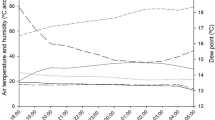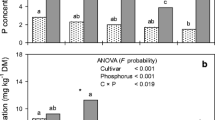Summary
The effect of P nutrition on the growth of tomato plants in peat was examined. Initially, plants received an adequate supply of P and then received either nil, 0.78 or 2.34 kg superphosphate per m3 in combination with either 50 μg N/ml (N1) or 300 μg N/ml (N2) as ammonium nitrate in a liquid feed. Vegetative growth was restricted in the lower P treatmentsi.e. inhibited shoot growth, reduced duration of leaf expansion phase, thinner stems and reduced vegetative dry wt. Plants receiving N2 showed a greater restriction in growth compared with N1 plants when the P supply was limiting. P deficiency disrupted protein metabolism in the leaves, in that soluble leaf protein was reduced and trichloroacetic acid-soluble N accumulated. Flower development was accelerated by low P applications but the final numbers of flowers and the fruit-setting efficiency were reduced. Lowering the N supply reduced the fruit yield by 36 per cent while an intermediate P level reduced yields by about 15 per cent. Maximum fruit yields and good vegetative growth occurred when plants contained 0.4 per cent P or above in the mature leaves, and this value was achieved by adding the highest level (2.34 kg/m3) of superphosphate to the peat.
Similar content being viewed by others
References
Adatia, M. H. 1976 Advisory and analytical service. Rep. Glasshouse Crops Research Inst.1975, p 77.
Besford, R. T. 1979 Uptake and distribution of phosphorus in tomato plants. Plant and Soil51, 331–340.
Besford, R. T. and Hobson, G. E. 1973 Glutamate oxaloacetate transaminase activity in developingLycopersicon esculentum fruit. Phytochemistry12, 1255–1260.
Biddulph, O. and Woodbridge, C. G. 1952 The uptake of phosphorus by bean plants with particular reference to the effects of iron. Plant Physiol.27, 431–444.
Davies, J. N. and Winsor, G. W. 1967 Effect of nitrogen, phosphorus, potassium, magnesium and liming on the composition of tomato fruit. J. Sci. Food Agric.18, 459–466.
Hogue, E., Wilcox, G. E. and Cantliffe, D. J. 1970 Effect of soil phosphorus levels on phosphate fractions in tomato leaves. J. Am. Soc. Hort. Sci.95, 174–176.
Kidson, E. B. and Stanton, D. J. 1963 ‘Cloud’ or vascular browning in tomatoes. VI. The mineral composition of the tomato plant in relation to ‘cloud’ N. Z. J. Agric. Res.6, 382–393 (1963).
Menary, R. C. and Staden, J. van 1976 Effect of phosphorus nutrition and cytokinins on flowering in the tomato,Lycopersicon esculentum Mill. Aust. J. Plant Physiol.3, 201–205.
Motsara, M. R. 1973 On the effects of phosphorus on zinc uptake by barley. Plant and Soil38, 381–392.
Roorda van Eysinga, J. P. N. L. 1971 Fertilization of tomatoes with phosphate. Agric. Res. Repts.No 755, 1–10.
Schropp, A. von and Marschner H. 1977 Wirkung hoher Phosphatdungung auf die Wachstumsrate, den Zinkgehalt und das P/Zn-Verhältnis in Weinreben (Vitis vinifera). Z. Pflanzenernaehr. Bodenkd.140, 515–529.
Smilde, K. W. and Roorda van Eysinga, J. P. N. L. 1968 Phosphorus deciency.In Nutritional Diseases in Glasshouse Tomatoes. Published by Centre for Agricultural Publishing and Documentation. Wageningen. p. 13.
Sobulo, R. A., Fayemi, A. A. and Agboola, A. 1975 Nutrient requirements of tomatoes (Lycopersicon esculentum) in southwest Nigeria. II. Foliar analysis for assessing nitrogen, phosphorus, and potassium requirements. Exp. Agric.11, 137–143.
Varley, J. A. 1966 Automatic methods for the determination of nitrogen, phosphorus, and potassium in plant material. Analyst London,91, 119–126.
Wallace, A. and Lunt, O. R. 1960 Iron chlorosis in horticultural plants. A Review. Proc. Am. Soc. Hortic. Sci.75, 819–841.
Warburg, O. and Christian, W. 1942 Isolation and crystallization of enolase. Biochem. Z.310, 384–421.
Winsor, G. W. 1973 Nutrition.In The U.K. Tomato Manual. Published by Grower Books. London pp 35–42.
Winsor, G. W. and Long, M. I. E. 1967 The effects of nitrogen phosphorus, potassium, magnesium and lime in factorial combination on ripening disorders of glasshouse tomatoes. J. Hortic. Sci.42, 391–402.
Winsor, G. W., Davies, J. N. and Long, M. I. E. 1967 The effects of nitrogen, phosphorus, potassium, magnesium and lime in factorial combination on the yields of glasshouse tomatoes. J. Hortic. Sci.42, 277–288.
Author information
Authors and Affiliations
Rights and permissions
About this article
Cite this article
Besford, R.T. Effect of phosphoros nutrition in peat on tomato plant growth and fruit development. Plant Soil 51, 341–353 (1979). https://doi.org/10.1007/BF02197781
Received:
Issue Date:
DOI: https://doi.org/10.1007/BF02197781




